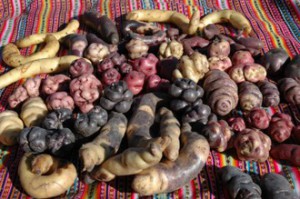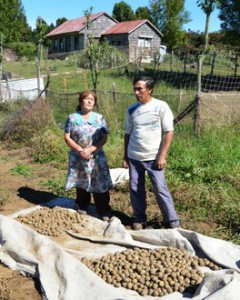 (8 April 2013) The Chirapaq Ñan (“rainbow route” in Quechua) has now been opened up. This is an initiative for monitoring and promoting the diversity and conservation of the agrobiodiversity of the native potato, as well as improving the well-being of the farmers who are custodians of the ancestral varieties, by means of the interconnection of micro-centers of high diversity (“diversity hotspots”) in several countries of Latin America.
(8 April 2013) The Chirapaq Ñan (“rainbow route” in Quechua) has now been opened up. This is an initiative for monitoring and promoting the diversity and conservation of the agrobiodiversity of the native potato, as well as improving the well-being of the farmers who are custodians of the ancestral varieties, by means of the interconnection of micro-centers of high diversity (“diversity hotspots”) in several countries of Latin America.
Set in motion under the Genetic Resource Program of the International Potato Center (CIP), the initiative is the first one to be carried out in the world to monitor the genetic diversity of a crop systematically in predefined places over time.
“In the era of globalization and climate change, the idea is to take the pulse of the genetic diversity of native species and varieties, something that has already been done for wildlife flora and fauna, for example, by the World Wildlife Fund, but which has not been done for such an important specific food crop as the potato,” explains Stef de Haan, leader of CIP’s Genetic Resources.
 So far, Chirapaq Ñan has identified four diversity hotspots, where studies will be made of the in-situ conservation dynamics (conservation in the place of origin) and the evolution of ancestral varieties of the different potato species. In this process, the communities are the main protagonists: in-situ conservation is a historical and socio-cultural phenomenon, so the idea is to get the farmers themselves actively involved.
So far, Chirapaq Ñan has identified four diversity hotspots, where studies will be made of the in-situ conservation dynamics (conservation in the place of origin) and the evolution of ancestral varieties of the different potato species. In this process, the communities are the main protagonists: in-situ conservation is a historical and socio-cultural phenomenon, so the idea is to get the farmers themselves actively involved.
Within the communities, a special role is played by ‘potato custodians or guardians’, people responsible for preserving the native varieties inherited from their ancestors. “The idea is also to promote the transfer of knowledge from one generation to the next,” explains De Haan. “We seek to ensure that the knowledge remains there at the local level, and that the young people have an active participation.”
Another innovative aspect is that this is a regional monitoring initiative with the participation of many stakeholders, including scientists, public institutions, and development professionals, together with the farmers themselves. Ten local consortia have been identified in six Andean countries (Argentina, Bolivia, Chile, Ecuador, Peru, and Venezuela), where small groups of some 100 families will be included. Although it is expected that the diversity will be very different among the different countries and consortia, it is hoped that a long-term partnership will be formed among diversity hotspots and communities for the exchange of experience and information.
The selection of the hotspots was made taking into account the geographic distance between them, thereby increasing the possibilities of obtaining greater and more distinct diversity. Four hotspots have already been identified, while the team headed by Stef de Haan continues extending the route in the Andean region. “We plan to open four more hotspots in the near future, in Argentina, Bolivia, Colombia and Ecuador,” he says.
His journey through the island of Chiloé, in southern Chile, at the beginning of March, gave him some pleasant surprises. To start with, the initiative has been very well received. “We hope that in the next few months a consortium will be formed to monitor the diversity of the Solanum tuberosum Chilotanum group in Chiloé,” remarks De Haan.  Then, an interesting discovery was to see how men and women can have a different relationship with the native crops. He was told there that, although the men were in favor of replacing the native potatoes by improved varieties, the women did not want to abandon the native varieties, because of their flavor and the experience of cooking with them. Finally, the women opted to grow improved potatoes in one furrow, and native potatoes in another.
Then, an interesting discovery was to see how men and women can have a different relationship with the native crops. He was told there that, although the men were in favor of replacing the native potatoes by improved varieties, the women did not want to abandon the native varieties, because of their flavor and the experience of cooking with them. Finally, the women opted to grow improved potatoes in one furrow, and native potatoes in another.
Testimonies and innovative experiences with the use of group knowledge is what Chirapaq Ñan also seeks to document, for example, through a DVD that will be the first educational product of the initiative. Stef de Haan and CIP colleagues met in Cusco, Peru, at the end of March, with partners from the non-governmental organizations CADEP José María Arguedas, HoPe, and Grupo Yanapai, to define the contents of the audiovisual product and the research methods to be used in the communities.
The method for gathering information is a project in itself, for it seeks to involve school teachers, children, and whole communities in the investigation and gathering of data about the traditions and customs surrounding the native potatoes. Three communities have been defined in the Peruvian departments of Apurímac, Cusco, and Huancavelica to carry out the educational and informational project that will be worked on together with Peru’s Ministry of Education.
The participation of several actors will be of key importance for the proposal. “I believe that at the end of the day we are trying to help the poorest sector, since it is the poorest people who are conserving the biodiversity,” says María Scurrah, of the NGO Yanapai, in reply to our question as to how she feels about the Chirapaq Ñan proposal.
Stef de Haan mentions that in the future the project will also seek to favor the well-being of small-scale farmers and potato producers, for example by obtaining health insurance. Scholarships for school children are also planned. “The International Treaty on Plant Genetic Resources for Food and Agriculture sets down the rights of farmers, but implementing it has always been the most complicated part,” he comments. “Chirapaq Ñan is looking for positive changes.”
